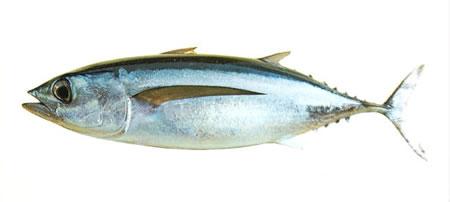As an albacore ages it feeds less on squid and more on fish such as saury, lanternfish, or rockfish. Albacore off Washington and Oregon feed primarily on saury and northern anchovy.
Description and Range
Physical description
Pectoral fin extremely long – extends well beyond front of anal fin except in specimens under about 1 ft. (30 cm). Usually 7-9 dorsal finlets, 7-8 anal finlets. Liver striated on ventral surface. 25-31 gill rakers on 1st arch. Dark blue above; shading to silvery white below. 1st dorsal fin deep yellow, 2nd dorsal and anal fins light yellow. Anal finlets dark. Caudal fin white-edged.
Lengths up to 4.6 ft and weights up to 133 lb.
Geographic range
Worldwide in temperate seas; rare in tropics; Alaska to Revillagigedo Island (Mexico). Open seas and clear water; seldom close to shore.
Regulations
Rules and seasons
Albacore tuna is one of the most sought after fish around the world, both commercially and recreationally, and are classified as a Highly Migratory Species. In the United States they are managed federally by National Marine Fisheries Service (NMFS) in cooperation with state fish and wildlife agencies.
Hook and line angling, spearfishing, and bow and arrow fishing only.
No minimum size and no possession limit. No daily limit, except YELLOWFIN, SKIPJACK, and NORTHERN BLUEFIN daily limit of 2 each.
Where you may encounter albacore tuna
Albacore tuna can be caught off the Washington coast in summer and early fall. Even though albacore can be caught all summer and into October during certain years, August and September are the most popular months as albacore are usually more abundant and the weather is normally calmer.
Albacore tend to be found in the "blue water", a mass of warmer Sea Surface Temperature (SST) water typically found off the West Coast of North America during summer and fall, and off Southern California year-round. Recreational anglers typically fish for albacore 40 to 100 miles off the Washington Coast, with commercial fishers regularly venturing even further. Occasionally albacore will come in as close as 30 miles and, on rare occasions, they have been known to come in as close as 15 miles or less.
Many charter boats target albacore out of Westport and Ilwaco on both one-day and multi-day trips, while independent (non-charter) anglers with large, ocean-capable boats also fish tuna out of these ports as well as occasionally La Push, Neah Bay and Sekiu when weather and water conditions allow. Recreational albacore trips can last one to three days depending on the distance traveled to the tuna grounds.
How to fish for albacore tuna
The primary methods for albacore fishing off the Washington Coast are fast trolling with plugs, Rapalas, clones (plastic squid), leadhead jigs or other trolling lures, vertical jigging with lead and iron jigs, and live bait fishing with live anchovies on single hooks. Live bait fishing is especially popular and productive when a tuna school is near the surface. Some recreational and commercial tuna fishers also use jack pole and handline setups effectively.
Yellowtail amberjack, bluefin tuna, skipjack tuna, mahi mahi, striped marlin, and other pelagic fish species are sporadically caught by Washington tuna anglers.
State record
- Weight
- 52.00 lbs
- Angler
- Kurt Strickland
- Location
- Pacific Ocean, Grays Harbor County
- Date Caught
- October 1, 1997
